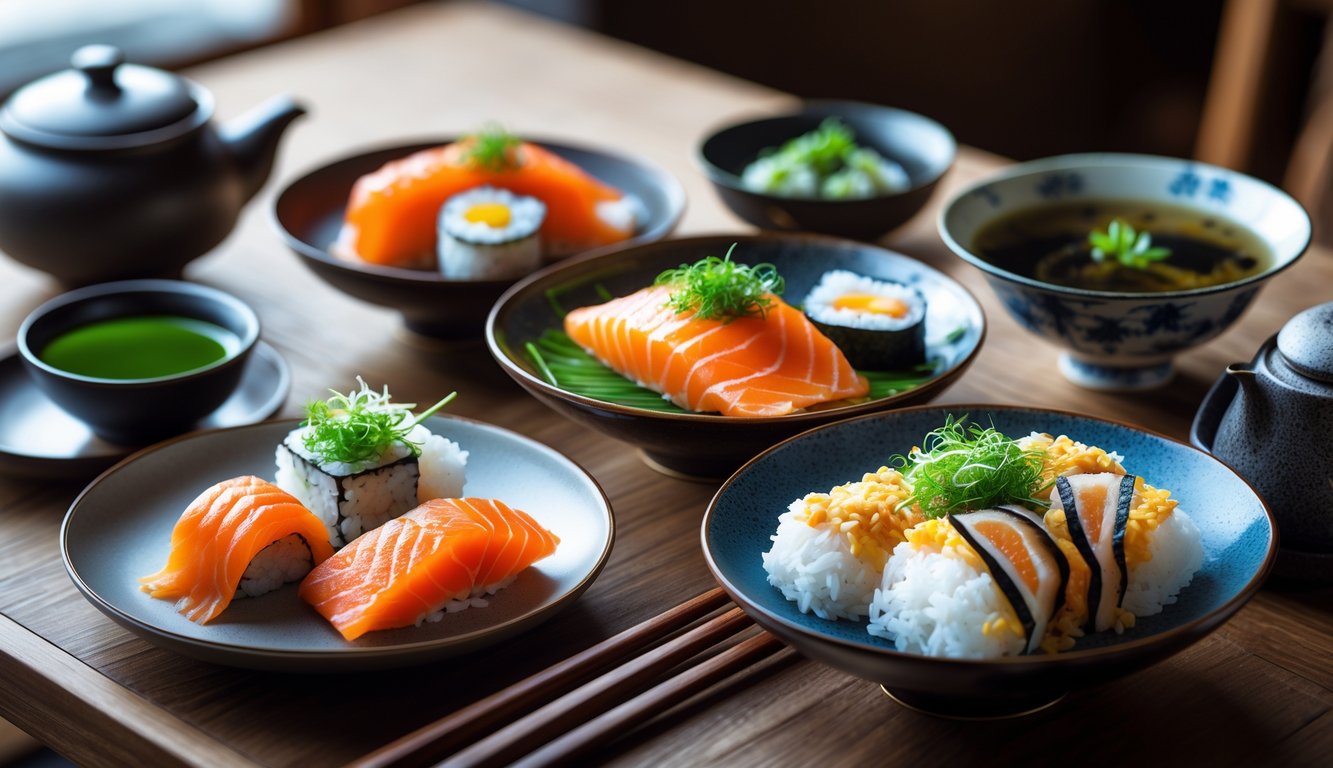
Satisfying Rituals And Presentation
I stare at my rice, salmon roe scattered on top, and realize: this isn’t just about looking pretty. Presentation in Japanese food actually changes how full I feel. There’s some ritual, some sneaky structure, and once you notice, takeout just feels…sad.
Aesthetics And Plating
Why is the tofu always a perfect square with one snap pea balanced on top? Japanese plating is a trick. The five-color rule—red, yellow, green, black, white—shows up even in the messiest omurice. It’s not for Instagram. Supposedly, Kyoto University says we eat 15% slower when the colors pop. Is that true? I have no idea, but I do eat slower.
Every bite feels deliberate, even when I’m rushing. They cut, boil, grill, steam, fry—anything to keep things mixed up. Sameness? Appetite killer. The art of Japanese plating goes so far, I once saw a chef swap bowls five times just to match the bean sprouts. I tried that after work. Regretted it. But, weirdly, leftovers taste more like “real food” when you try.
Empty space isn’t just empty. That gap in the donburi bowl? It’s a breather for your brain. See the emptiness, slow down, eat less, and somehow you feel satisfied, not stuffed. My plastic lunch boxes never pull that off.
Tradition Of Kaiseki
Kaiseki meals? I never know what’s happening. Which mushroom is the main? Doesn’t matter. Every plate has a theme, and you never get two of the same texture in a row—fish rice, grilled bamboo, tart, soup. They call it washoku, like edible poetry, but really, it’s just strict. Try faking it; real kaiseki is as rigid as tax law.
Chefs spend years mastering one dish. Why? I don’t know, but food historians say it started with monks making boring food sacred, so that eleven-miso-cup marathon is serious business. Bourdain said he felt “interrogated by garnishes” and, yeah, that’s the vibe. You eat slower, you think less about being full, and you wonder if you’re doing it wrong.
I’ve done the Kyoto kaiseki thing, sweating bullets, trying not to pour my own sake or eat pickles at the wrong time. Comfort is engineered, not luck.
Home-Style Japanese Dining
Even quick dinners at home—just a jumble of dishes—feel more organized than most Western restaurant meals. Home-style Japanese dining is all about stacking little things: rice, grilled fish, miso soup, pickles. You walk away light, not starving.
Family meals aren’t about arguing over seconds. It’s chaos, bowls get passed around, nobody talks about the food, just eats. The recipes don’t hide behind butter or cream—just clean flavors, layered. Miso soup, pickled daikon, half a tamagoyaki, repeat.
Most of the world treats recipes like instructions; in Japan, they’re more like mood boards. Layout matters as much as ingredients. I dropped a fish bone in my tea once and nobody cared. The meal isn’t about perfection, it’s about rhythm and shape. The repetition is what fills you up.
Savory Sauces And Condiments
People ask why I keep going back to Japanese food when I’ve eaten the same bowl four days straight. Easy: condiments. One shake, one splash, and suddenly bland rice is dinner. Or at least, not terrible.
Soy Sauce In Every Meal
I waited in line at a ramen shop and watched a guy drown his pork in soy sauce. Totally normal. Soy sauce ends up in everything—grilled salmon, eggs, tofu, whatever. Kikkoman pumps out oceans of the stuff, but it doesn’t taste the same at home. Maybe it’s the 18-month fermentation? Grab the low-sodium bottle if you want, but the umami hit isn’t just about salt (which, let’s be honest, is still high). I met a chef who travels with his own soy sauce. That’s commitment. Regional stuff tastes wildly different—try a taste test and see if the waiter glares at you.
Rice Vinegar And Its Uses
Rice vinegar: one wrong bottle, and your sushi night tanks. Plain rice is fine, but Japanese families pull out the vinegar for everything. Just a few drops, and the whole plate wakes up. It’s not apple cider vinegar (which, side note, is overrated), and definitely not white vinegar. Sushi chefs mix their own blends—sometimes with seaweed or sake lees. I saw “glucose for mouthfeel” on a label once. No idea if that’s real. At the table, rice vinegar, soy sauce, chili oil—it all gets mixed for gyoza or ramen. Does anyone actually like straight vinegar? I don’t.
Flavor Boosters
I used to think ground sesame was just garnish. Wrong. Dump a spoonful in ramen, and suddenly it’s addictive. Surigoma, chili oil, shichimi togarashi, yuzu kosho—each one changes the game. Every place has some secret condiment. Why do some shops hand out powdered garlic in little packets? No clue. It’s not about heat, it’s about dragging out that savory thing you expect now. The jars line up, and if I skip one, dinner feels flat. Add three, and I sit at the table twice as long. Garlic, miso paste, black garlic oil—they rotate in and out, but nobody advertises them like signature dishes. Japanese restaurants just leave them out, half the time unlabeled, and you have to trust whoever brought you. That’s customization. Or chaos.
Cultural Influences On Dining Satisfaction
Here’s the part I can’t figure out: no matter where I eat—random supermarket sashimi, some Michelin place—Japanese dinners always linger. It’s not the plates. Not the chairs. Something else. The rhythm, the rituals, the etiquette that makes me sweat, the menus that change with the seasons. Maybe it’s all of it, or maybe I’m just overthinking dinner again.
Food Culture And Social Connection
So, eating in Japan with other people—honestly, it’s a whole thing. I showed up for my first work dinner thinking, “Cool, food, whatever,” and instead got schooled in the weirdly synchronized ballet of group dining. People aren’t just eating. They’re…I don’t know, vibing? You can almost feel everyone tracking each other’s pace, like, “Should I grab another slice or is that rude?” I used to think eating together was just background noise, but here, nope, it’s the main event.
Shabu-shabu? Total social experiment. You’re hovering over the hot pot, trying to act casual, but you’re actually watching everyone for cues—when to drop your veggies, when to laugh, when to just stare at your broth and pretend you’re not waiting for the next round. There’s this study that says eating out here is basically group therapy with food. Back home, nobody cared if you swiped the last gyoza. Here, it’s like a trust fall.
And if you don’t toast with umeshu at least once, are you even trying? It’s not just a drink, it’s like a secret handshake.
Seasonal Celebrations
Cherry blossom season. I mean, yeah, it’s pretty, but what’s wild is how the food hits reset. Spring rolls in, and suddenly my miso soup tastes like, well, spring? Not even making that up. Every restaurant, every bento shop, even those grumpy old izakaya guys—everyone’s shoving fuki, bamboo shoots, sakura shrimp into the mix. It’s like the country collectively loses its mind over what’s in season.
Meibutsu—supposedly “famous local food”—isn’t just a tourist trap. It’s more like a sign flashing, “Hey, you’re allowed to enjoy this now.” I didn’t get it at first, but then matsutake rice in autumn happened, and now I’m weirdly sentimental about mushrooms. Chefs get all territorial about their region’s stuff, too—like, don’t even try to say Hokkaido crab is better in Tokyo. For a rabbit hole, see this seasonality deep-dive.
Modern Japanese Restaurants
Trying to book a Tokyo restaurant? Prepare for rules. Michelin stars? Sure, but nobody’s flashing gold-plated anything. Minimalism just slaps you in the face—tiny plates, everything spaced out, no weird sauce doodles. And if you stick your chopsticks in rice, staff will give you the look. Why? Who knows, but you’ll do it wrong once.
Tokyo’s got over 200 Michelin-starred places now, but honestly, some ramen counter in a back alley can be just as satisfying. The etiquette’s different—here, slurping is not only fine, it’s expected, and I wish I could get away with that anywhere else. Every spot, fancy or not, is obsessed with the details—order, color, even the way you say “thank you” after each dish. Want to get nerdy? Here’s a breakdown of the whole aesthetic thing.
Saw a chef once using tweezers on pickled ginger, muttering about “Washoku.” I tried it at home—looked like a crime scene. Don’t ask.



